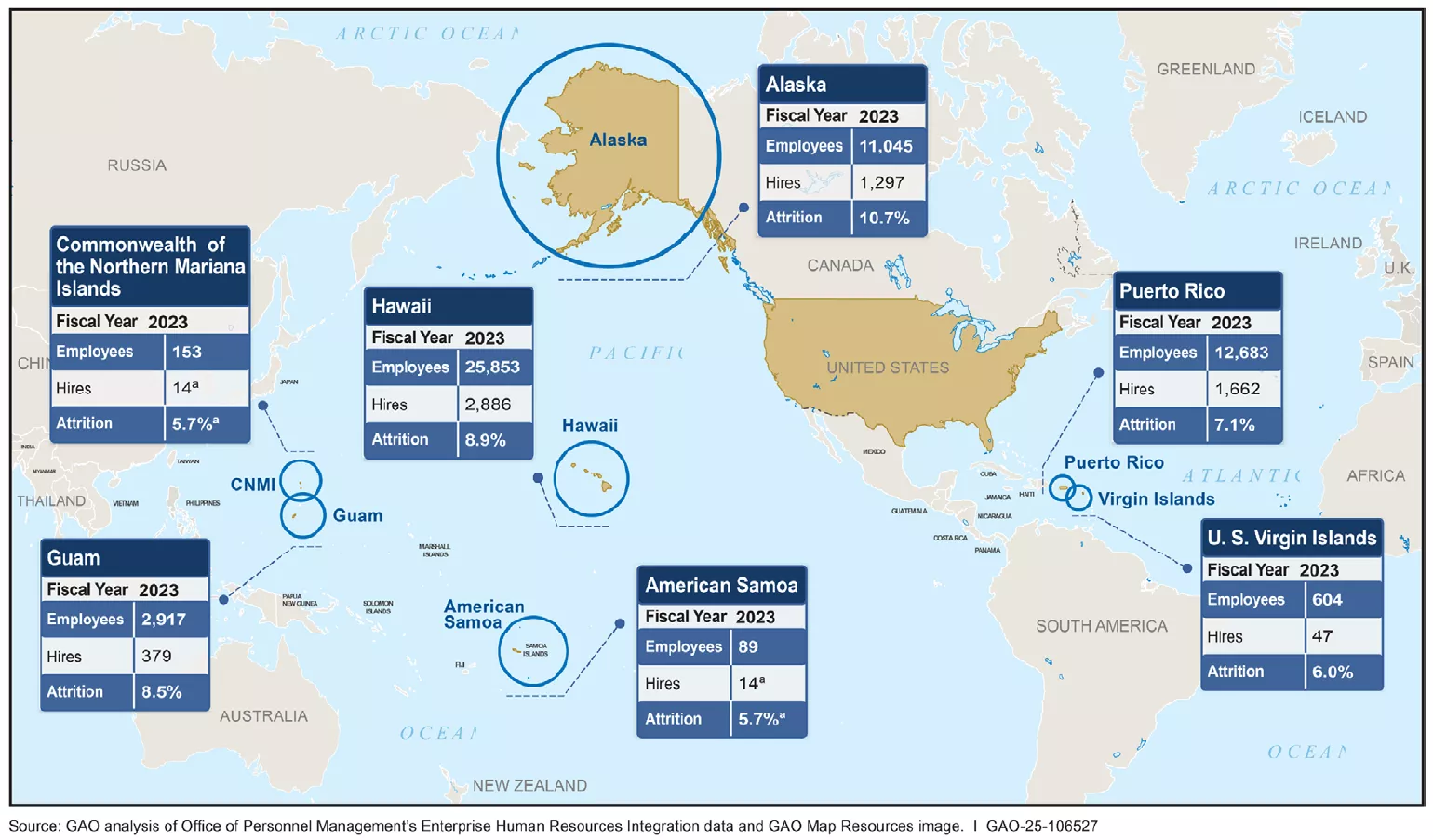Federal jobs in Hawaii and Alaska—Sounds like a dream. So why are they so hard to fill?
You might think job hunters would be clamoring for an opportunity to work from a winter wonderland like Alaska or island paradises like Hawaii and the U.S. territories in the Caribbean Sea and Pacific Ocean. But the federal government has struggled to find workers with the skills it needs to fill jobs in these more remote parts of the United States.
Today’s WatchBlog post looks at our new report on why hiring and retaining federal employees in the territories, Hawaii, and Alaska has been difficult.
Waikiki Beach in Honolulu, Oahu with Diamond Head Crater in the background
Image

Working from paradise comes with some costs
You don’t need to be a volcanologist to find a federal job in Hawaii or a fish and wildlife expert to work in Alaska. Dozens of federal agencies with a range of hiring needs and missions are looking for employees. These include agencies like FEMA, TSA, the Social Security Administration, the National Park Service, and the Fish and Wildlife Service (among others).
The federal government needs a workforce across the country to help address U.S. social, economic, and security challenges. This includes areas distant from the mainland like Alaska, Hawaii, and the territories. But finding people with the right skills—and keeping those employees—has been challenging for several reasons.
High costs can stack up. Higher prices for housing, education, gas, and groceries in these locations can become a significant financial strain for employees.
Higher costs for basic living expenses may prevent some people from taking a job. They may also cause those who have accepted jobs to leave shortly after the government paid to relocate and train them. For example, a National Park Service official in Hawaii said that new employees from the mainland often don’t fully understand how higher costs will affect them. As a result, some non-local hires withdraw their applications or leave their positions, sometimes within as little as a year.
Examples of Grocery Prices in Bethel, Alaska in August 2023
Image

Lack of available housing and services may also deter skilled candidates who don’t already live in the area from applying for jobs. For example, in Alaska, officials told us applicants turned down positions because they couldn’t find a place to live.
In American Samoa, hiring officials said that not having reliable internet access can also affect local candidates’ ability to apply for jobs online. Officials in Guam expressed similar concerns about internet access—adding that finding childcare and good schools can also have an impact on recruitment and retention.
Limited career growth opportunities, locally. Federal employers also told us that without career growth opportunities, employees feel they must leave remote areas to move up or make more money. For example, FEMA officials said that employees looking to advance their careers must often transfer to the mainland.
Why not hire local candidates? Many agencies are trying to do just that. But officials said—in general—that small local populations don’t always have people with the necessary skillsets to fill open positions. For example, a FEMA official in Alaska told us that there are limited employment and training opportunities in their region that would allow locals to gain the skills and experience needed for open positions.
In addition, when federal agencies can find qualified local candidates, they face fierce competition from other employers in and outside of the area. For example, Social Security Administration staff said many local young professionals prefer to work on the mainland, which has caused a “brain drain,” in Hawaii. TSA staff in Guam and Alaska noted similar competition issues.
Snapshot of Federal Employment Data by Location, FY 2023
Image

What are agencies doing to make these locations more appealing?
Federal agencies are working to attract candidates through incentives and improve local recruitment efforts.
Helping with the costs. For example, TSA now can offer expanded relocation incentives for staff who sign a 12-month service agreement at hard-to-hire airports. The Fish and Wildlife Service will also pay to move employees back home after 2 years of service in some cases.
Some agencies can offer housing in areas with limited options. Some are also offering pay and retention incentives. For example, TSA has provided temporary pay increases, when possible.
Improving local recruitment efforts. Agencies are also working to attract and increase the local pool of qualified candidates. For example, in Guam, FEMA and the local government have partnered to communicate job announcements and organize job fairs. Officials from Fish and Wildlife Services in Puerto Rico and the U.S. Virgin Islands are working with local universities to share job opportunities.
But even with these efforts, hiring staff at agencies we met with said there is more that mainland offices could do to understand the unique needs of these geographic areas. This includes using employee feedback to address challenges. We also think agencies could do more to address commonly cited challenges—such as improving access to live virtual trainings at times that work for employees in other time zones.
Read our full report to learn more about our work and recommendations to improve federal hiring efforts in Alaska, Hawaii, and the territories.
- GAO’s fact-based, nonpartisan information helps Congress and federal agencies improve government. The WatchBlog lets us contextualize GAO’s work a little more for the public. Check out more of our posts at GAO.gov/blog.
- Got a comment, question? Email us at blog@gao.gov.
GAO Contacts
Related Products

GAO's mission is to provide Congress with fact-based, nonpartisan information that can help improve federal government performance and ensure accountability for the benefit of the American people. GAO launched its WatchBlog in January, 2014, as part of its continuing effort to reach its audiences—Congress and the American people—where they are currently looking for information.
The blog format allows GAO to provide a little more context about its work than it can offer on its other social media platforms. Posts will tie GAO work to current events and the news; show how GAO’s work is affecting agencies or legislation; highlight reports, testimonies, and issue areas where GAO does work; and provide information about GAO itself, among other things.
Please send any feedback on GAO's WatchBlog to blog@gao.gov.




